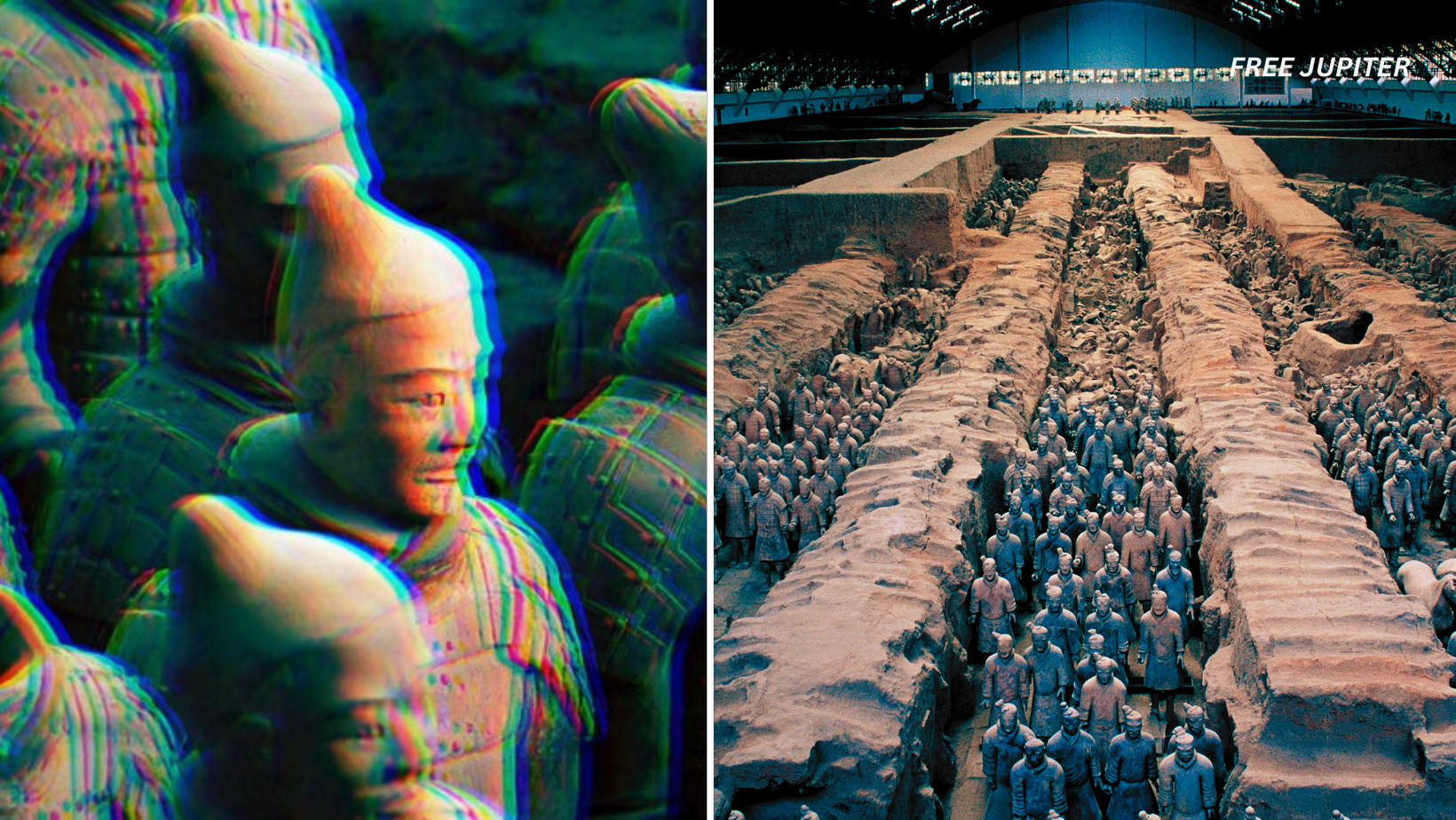For more than two millennia, the final resting place of China’s first emperor has remained untouched—shrouded in mystery, legend, and an air of caution. Despite the allure of unimaginable treasures and ancient secrets buried within, Qin Shi Huang’s tomb continues to be left unopened by modern archaeologists. The decision has not stemmed from a lack of curiosity, but rather from a deep-rooted fear of what might be waiting behind its sealed walls.
Discovered in 1974 in China’s Shaanxi province, the tomb site has fascinated historians and researchers worldwide. A group of unsuspecting farmers had been digging a well when fragments of the now-iconic Terracotta Army emerged from the earth. Since then, the site has been extensively explored—yet the central burial chamber, believed to house the emperor himself, has been deliberately left untouched.
Guarded by an Army Made of Clay
Qin Shi Huang, the formidable founder of the Qin Dynasty, ruled with an iron grip from 221 BC until his death in 210 BC. His ambition knew no limits, and neither did the grandeur of his tomb. To safeguard him in the afterlife, a massive army of terracotta warriors, complete with horses, chariots, and weapons, was crafted and buried near his mausoleum. These life-sized statues, estimated to number in the thousands, were created with meticulous detail. No two soldiers are exactly alike.
This protective force was not merely symbolic. It was meant to serve as a powerful barrier between the emperor and any would-be intruders, both in the spiritual realm and the physical world. The sheer scale of this project remains a marvel of engineering, craftsmanship, and imperial authority.
A Tomb Cloaked in Ancient Warnings
Despite the wealth of knowledge gleaned from excavations around the site, one major structure has been strictly avoided—the emperor’s burial chamber itself. Many scholars have raised valid concerns, warning that opening it could result in irreversible damage to its contents, or worse, to those involved in its breach.
Chinese historian Sima Qian, writing over a century after Qin Shi Huang’s death, provided detailed descriptions of what lay within the tomb. According to his records, elaborate palaces and towers were constructed inside, meant to resemble the emperor’s worldly kingdom. It was said that the underground complex had been adorned with exquisite treasures and rare artifacts.
But there was something even more ominous. According to Sima Qian’s account, sophisticated traps had been installed to thwart intruders. Crossbows, reportedly rigged to fire automatically, were said to have been positioned throughout the tomb’s interior. These deadly weapons were designed to fire the moment a trespasser crossed a certain threshold.
And the dangers did not end there.
Read more: The Discovery Of A 1,200-Year-Old Ship ‘Laden With Cargo’ Is Rewriting The History Books
A River of Mercury Beneath the Ground
Perhaps the most unsettling aspect of Sima Qian’s writings involved the use of mercury. It was claimed that vast quantities of the toxic liquid had been employed to simulate China’s major rivers—the Yangtze, the Yellow River, and even the seas. Mechanisms were allegedly installed to keep the mercury in motion, creating an eternal flowing illusion to mirror the emperor’s earthly dominion.
While such tales may have once seemed like pure legend, modern science has lent unexpected credibility to these ancient stories. Soil samples taken from the site have shown unusually high levels of mercury, suggesting that the historian’s claims might not have been entirely fictional. One scientific study from 2020 pointed out the disturbing possibility that mercury vapor could be slowly leaking from the tomb through structural cracks. The findings appeared to support the notion that the chamber has remained sealed and untouched since its creation.
“Highly volatile mercury may be escaping through cracks, which developed in the structure over time,” the study reported. “Our investigation supports ancient chronicle records on the tomb, which is believed never to have been opened or looted.”
Technology vs. Preservation
Modern archaeologists and researchers have long debated whether the tomb should be opened. On one side are those who believe the wealth of knowledge and cultural insight inside the tomb could revolutionize our understanding of early Chinese civilization. On the other side are those who insist that disturbing the site could cause irreparable damage—not only to its fragile contents but also to the integrity of one of the world’s most significant archaeological sites.
So far, caution has prevailed.
It has been suggested that non-invasive technologies, such as ground-penetrating radar, magnetic surveys, and 3D imaging, could provide insight without physically opening the tomb. These techniques are being actively considered and, in some cases, already applied. However, the decision to initiate a full-scale excavation has yet to gain consensus. The risks—both known and unknown—have proven too great.
Read more: Gargantuan Ancient Forest Found 630 Feet Below Ground In Massive Chinese Sinkhole
Why the Tomb Remains Sealed
Many factors contribute to the decision to leave the tomb untouched. Among them, scientific, ethical, cultural, and spiritual considerations all play a role.
- Preservation Concerns: Ancient artifacts and structures are often extremely fragile. Exposure to air, light, and microbial organisms can cause rapid deterioration. Without proper containment and preservation technology, priceless relics could be lost forever within moments of exposure.
- Toxic Risks: With evidence pointing to the presence of mercury, health hazards cannot be dismissed. If significant quantities of the substance remain inside, it could pose a danger not just to researchers but also to the surrounding environment.
- Historical Respect: For many in China, disturbing the final resting place of such a pivotal historical figure is considered deeply disrespectful. Cultural reverence for ancestors and spiritual beliefs about the sanctity of the dead play a strong role in decision-making.
- Unpredictable Traps: Though it may sound like something out of a Hollywood movie, concerns about ancient booby traps persist. The ingenuity of ancient Chinese engineering is well-documented. The possibility of automated weapons or other mechanisms remains a chilling unknown.
A Legacy Meant to Last Forever
Qin Shi Huang was more than just China’s first emperor. He was a figure of immense ambition and ruthless determination. His reign saw the unification of the warring states, the construction of the Great Wall’s early foundation, and sweeping reforms that would shape Chinese civilization for generations.
His tomb was intended as a testament to his power and vision. Everything about it—from its size and complexity to its legendary defenses—suggests that it was built not just to honor the dead, but to outlast time itself.
And so far, it has.
Over 2,200 years later, the secrets of the tomb remain undisturbed. They continue to captivate historians, archaeologists, and the public alike. But for now, the decision to let the emperor rest remains firm.
Read more: Pythagorean Theorem Found on Ancient Tablet 1,000 Years Older Than Pythagoras Himself
The Future: To Open or Not to Open?
As technology continues to evolve, the temptation to finally open the tomb may grow stronger. Advanced robotics, AI-assisted analysis, and remote scanning tools could offer safer methods to peer inside. However, the dilemma remains unresolved.
The promise of unparalleled discoveries stands against the fear of destruction. The balance between curiosity and caution has yet to be tipped. Until then, the mausoleum of Qin Shi Huang will continue to guard its mysteries in silence.
It stands as a haunting reminder: some treasures of the past are best left in peace—at least for now.










